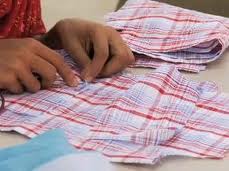INTRODUCTION
The shift from a rural/agro based economy to an urban/industrial economy is an essential part of the process of economic development. Although policymakers in the least developed countries (LDCs) have, at various times, attempted to make agriculture the primary engine of economic growth and employment generation, this approach has not worked, not least because of the contributions of the Green Revolution, which has had the dual effect of increasing agricultural productivity in the LDCs and displacing the rural labor force at the same time.
Led by the example of the East Asian economies, most LDCs now accept the need for greater industrialization as the fastest path to economic growth. In particular, countries such as Japan, Taiwan and South Korea have demonstrated that an export-oriented industrial strategy can not only raise per capita income and living standards in a relatively short time; it can also play a vital role in modernizing the economy and integrating it with the global economic system.
Bangladesh, one of the representatives of LDCs, has also been following the same direction for the last 25 years. New rules had come to govern the international trade in textiles and apparel, allowing low-cost suppliers to gain a grasp in American and European markets. Assisted by foreign partners, and largely unaided by the government, entrepreneurs seized the opportunity and exploited it to the fullest.
Over a period of 25 years, the garments export sector has grown into a $6 billion industry that employs over a million people. In the process, it has boosted the overall economic growth of the country and raised the viability of other export-oriented sectors.
LITERATURE REVIEW
Several authors have analyzed aspects of the garment industry in Bangladesh. Of the various aspects of the industry, the problems and the working conditions of female workers have received the greatest attention.
A study by Md. Salim Uddin and Mohammed Abu Jahed (2007) revealed that how the RMG sector is contributing as prime mover of the socio economic development of Bangladesh. According to them, the garments industry has been leading the Bangladesh economy since the early 1990s. Garments are the country’s biggest export making up about three quarters of total exports, and the industry is a symbol of the country’s dynamism in the world economy. The industry is also the main non-farm formal sector creating employment opportunities for the poor. The greater part of the workforce is female, less educated, and has migrated from rural areas. Thus, the garment industry is seen as contributing to poverty reduction in Bangladesh by providing employment opportunities with higher wages for the poor who would otherwise be engaged in low-wage economic activities in rural areas. There was much discussion about the survival of Bangladesh’s garment industry prior to the final phase out of the Multi-Fiber Agreement (MFA) from 1 January 2005 which was expected to greatly intensify competition in the international garment market. One of the most influential forecasts was that only China and India would gain from the MFA phase out and that Bangladesh and other smaller suppliers of garments would lose out. Fortunately, there was no immediate major adverse effect in Bangladesh. Garment exports to the United States grew over the whole of 2005, while those to EU declined only slightly. However, the prospects for the industry in Bangladesh are not certain and the future trend in garment exports needs to be watched.
Dr. Greg gajewski & Alex Riley (2005) discussed about Bangladesh’s export trade practices and their effect on the competitiveness of the garment industry. They said, a wide body of evidence suggests that increased openness to trade and greater export competitiveness contribute to higher rates of economic growth. Export competitiveness depends, in part, on Customs and other administrative export trade practices, as well as on the efficiency of port operations and the transportation linkages between the ports and the main centers of export production.
A study by Munir Quddus & Salim Rashid looks at the aspects of garments exports from Bangladesh. They summarized that, the success of readymade garment exports from Bangladesh over the past two decades has surpassed the most optimistic expectations. The paper reviews the literature on this industry, presents recent data on the sector’s performance, and evaluates future trends in the international and domestic clothing industry. More specifically, the paper evaluates the negative impact of the 1998 floods on the industry. It concludes that although the impact of the flood was unexpectedly benign, the entrepreneurs face important challenges from the health of the domestic banking sector, the East Asian economic crisis, and the deregulation of the global clothing business as a result of the phasing out of the Multi-fibre agreement in the year 2005.
In this particular study we will be focusing on the contribution of garments sector in the economy of Bangladesh, the involvement of women workforce in this sector. We will also highlight the ways to improve the efficiency of the labor force, the foreign earnings through the export of garments products. In the last part, we will have some recommendation as well as concluding remarks.
OBJECTIVES OF THE STUDY
To focus on the following issues, particularly:
I. The contribution of GDP on Bangladesh economy through garments industry
II. The effective utilization of labor by the garments of Bangladesh
III. Participation of women in the garments sector
IV. Foreign earnings through garments sector
V. Constraints faced by the garments of Bangladesh
VI. Proposed recommendation
METHODOLOGY OF THE STUDY
Research type
- The proposed study is a descriptive one.
- This study is developed from qualitative point of view.
Data sources
Following secondary sources will be used in order to collect or gather necessary information for preparing the report:
- Journals and literatures
- Internet/Web sites
- Books
Steps
In this study, we will use the following steps to accomplish the proposed tasks:
- The planning and designing of the layout or contents of this report
- Selection of data sources
- Collection of data from those selected sources
- Provide in-depth analysis and explanation in order to clarify the study topic
- Point out the main findings of the study
- Propose some recommendations based on the findings
- Give a concluding remarks
DEVELOPMENT OF GARMENTS INDUSTRY IN BANGLADESH
In the field of industrialization, role of textile industry is found very prominent in both developed and developing countries. Economic history of Britain reveals that in the 18th Century the cotton mills of Lancashire in Britain ushered in the first industrial revolution of the world. Moreover, during the last 200 years or more many countries of the world have used textile and clothing industry as an engine for growth and a basis for attaining economic development. Over the past few years garment industry is found to have played such an important role in the process of industrialization and economic growth. This industry is in fact trying to put the wheel of her declining economic back to the track by giving essential life blood to it. The growth of garment industry in Bangladesh is a comparatively recent one.
In the British period there was no garment industry in this part of the Indo-Pak-Sub-Continent. In 1960 the first garment industry in Bangladesh (Then East Pakistan) was established at Dhaka and till 1971 the number rose to give. But these garments were of different type intended to serve home market only. From 1976 and 1977 some entrepreneurs came forward to setup 100% export oriented garment industry. Both domestic and international environment favored the rapid growth of this industry in Bangladesh. By mid seventies the established developed suppliers of garments in the world markets i.e. Hong Kong, South Korea, Singapore, Taiwan, Thailand, Malaysia, Indonesia, Sri Lanka and India were severely constrained by the quota restrictions imposed by their major buyers like USA, Canada and European Union. To maintain their business and competitive edge in the world markets, they followed a strategy of relocation of garment factories in those countries, which were free from quota restrictions and at least same time had enough trainable cheap labor. They found Bangladesh as one of the most suitable countries.
Available records show that the first consignment of garments was exported from the country in 1977 by Reaz and Jewel Garment. Desh Garment was the first biggest factory that started functioning at Chittagong in 1977. In fact that was the humble beginning of new joint venture garment factory in Bangladesh. Thereafter many entrepreneurs became interested and started to setup garment factories following the Desh garment and realizing the future prospects globally as well. Available records also show that one of the reasons of the growth of garment industry in Bangladesh is the collaboration of a local private garment industry, Desh garment with a Korean company, Daewoo. As part of its global strategies, the Daewoo Corporation of South Korea became interested in Bangladesh when the Chairman, Kim Woo-Choong, proposed an ambitions joint venture to the Government of Bangladesh which involved the development and operation of tyre, leather goods, cement and garment factories. South Korean Company, Daewoo, a major exporter of garments, was looking for opportunities in countries for using their quotas subsequent to the signing of MFA in 1974. Because of the quota limitation for Korea after MFA, the export of Daewoo became restricted. Bangladesh as a LDC got the opportunity to export without any restriction and for this reason Daewoo interested to use Bangladesh for their market. The reason behind this desire was that Bangladesh will depend on Daewoo for importing raw materials and at the same time Daewoo will get the market in Bangladesh.
For this desire Daewoo signed a five years collaboration agreement with Desh Garment. It included collaboration in the areas of technical training, purchase of machinery and fabric, plant setup and marketing in return for a specific marketing commission on all exports by Desh. The outcome of the collaboration of Desh-Daewoo was significant. In the first six years of its operation, Desh export value grew at an annual average rate of 90 percent reaching more than $ 5 million in 1986-87. Table-01 shows the trend of growth and development of garment industry in Bangladesh.
Table-01: Growth of garments factories in Bangladesh

The Table-01 shows that the growth was very slow till 1977 and got momentum from 1977 to 2005-06 in terms of number of industry. But the compound growth rate was highest till 1981 and the rate was very good during 1989-90 to 1994-95 and thereafter i.e. 1994-95 to 2004-05, the industrial growth has been declined though the numbers of industries have been increased.
SOME KEY FACTS – THE GARMENT SECTOR, TRADE, AND BANGLADESH’S ECONOMY
The garment sector is one of the most important components of Bangladesh’s economy.
- Garment exports were an estimated $5.8 billion USD out of total merchandise exports $7.8 billion USD in 2004, making them the nation’s largest source of exports.
- Garment sector exports accounted for 9.5% of GDP in FY 2003/4.
- The garment sector is an important source of employment generation and currently provides employment for over 2 million people or approximately 3% of the labor force.
- As 90% of the workforce in the garment manufacturing sector is female, the garment sector is particularly important for women’s employment.
- The garment sector is a key provider of employment and income to the urban poor.
- The sector is concentrated in Dhaka and Chittagong, where approximately 90% of the factories are located.
CONTRIBUTION OF GARMENTS INDUSTRY TO THE ECONOMY
Garments Industry occupies a unique position in the Bangladesh economy. It is the largest exporting industry in Bangladesh, which experienced phenomenal growth during last two decades. The industry plays a key role in employment generation and in the provision of income to the poor. Nearly two million workers one directly and more than ten million inhabitants are indirectly associated with the industry. The sector has also played a significant role in the socio-economic development of the country. In such a context, the trend and growth of garments export and its contribution to total exports and GDP has been examined the following table shows the position.
Table-02: Growth and trend of garments exports, and contribution to GDP

It is revealed from the Table-02 that the value of garment exports, share of garments export to total exports and contribution to GDP have been increased significantly during the period from 1984-85 to 2005-06. The total garments export in 2005-06 is more than 68 times compared to garments exports in 1984-85 whereas total country’s export for the same period has increased by 11 times. In terms of GDP, contribution of garments export is significant; it reaches 12.64 percent of GDP in 2005-06 which was only 5.87 percent in 1989-90. It is a clear indication of the contribution to the overall economy. It also plays a pivotal role to promote the development of linkage small scale industries. For instance, manufacturing of intermediate product such as dyeing, printing, zippers, labels has began to take a foothold on limited scale and is expected to grow significantly. Moreover it has helped the business of basling, insurance, shipping, hotel, tourism and transportation. The sector also has created jobs for about two million people of which 70 percent are women who mostly come from rural areas. The sector opened up employment opportunities for many more individuals through direct and indirect economic activities, which eventually helps the country’s social development, woman empowerment and poverty alleviation. In such a way the economy of Bangladesh is getting favorably contribution from this industry.
THE COMPETITION
From the many corners it was predicted that China would expand its exports and India would follow, and that the other relatively small exporters would suffered seriously from the competition of these two giants. However, it turned out that some garment-exporting Least Developed Countries (LDCs), such as Bangladesh, Cambodia and Haiti, faired very well throughout the year 2005. In this context, an attempt has been made to examine the export data of selected countries during MFA and post MFA to US and EU markets in order to assess the indicative impact of post MFA scenario in Bangladesh as well as other largest garments exporters. The following Tables show the picture in this regard.
Table-03: Exports of knit and woven garments to the United States

Tables 03 and 04 show the trends in garment exports to the United States and EU from the five largest garment exporters and the two leading exporters among the LDCs, Bangladesh and Cambodia. It was revealed that China and India expanded garment exports to the US and EU, the world’s two largest markets. Along with China and India, Bangladesh and Cambodia have also increased their exports to the United States during 2005 by more than 20 percent. Though their garment exports to the EU declined between 2004 and 2005, the drops were not significant; and the growth in the same figures by more than 30 percent between 2003 and 2004 surpassed the decline in 2005 (Table 04). As a whole, the sum of garment exports to the two largest markets grew by 2.54 percent for Bangladesh and by 11.06 percent for Cambodia in 2005. Since the US and EU are going to be imposing new restrictions on textile and garment imports from China for at least a couple of years, exports from that country will slow down, making room for the remaining garment exporters to increase growth. Thus, the prospects for Bangladesh to continue expanding its garment exports are encouraging.
PARTICIPATION OF WOMEN IN THE GARMENTS SECTOR
Garment sector is the largest employer of women in Bangladesh.The garment sector has provided employment opportunities to women from the rural areas that previously did not have any opportunity to be part of the formal workforce. This has given women the chance to be financially independent and have a voice in the family because now they contribute financially. In 2006, the industry provided jobs for 4.5 million people, 80% of whom were women.

However, the women workers are facing many problems. Most women come from low income families. Low wage of women workers and their compliancy have enabled the industry to compete with the world market. Women are paid far less than men mainly due to their lack education. Women are reluctant to unionize because factory owners threaten to fire them. Even though trade unionization is banned inside the Export Processing Zones (EPZ), the working environment is better than that of the majority of garment factories that operate outside the EPZs. But, pressure from buyers to abide by labor codes has enabled factories to maintain satisfactory working conditions. In recent times, garment workers have protested against their low wages. The first protests broke out in 2006, and since then, there have been periodic protests by the workers. This has forced the government to increase minimum wages of workers.
GARMENTS PRODUCT PORTFOLIO AND ITS DIVERSIFICATION
The specific character of products and level of industrial development indeed determines its variance of product diversification. In such a context, the product mix, product line as well as product diversification are very important strategies for any industry to develop its market by meeting the present market requirements. For the garments industry it is also very important because product diversification will call for developing capability for product development and product design especially in response to fast changes in fashion. The growth pattern of garments export can be categorized into two distinct phases. During the initial phase it was the woven category. Second phase is the emergence of knitwear products. On the other hand, an analysis of the product mix of the garments industry revealed that so far Bangladesh has been able to export very limited categories of products. In such a context, an attempt has been made to examine the growth and trend of product portfolio or categories of products exported from Bangladesh.
The position can be better explained if we look into the more details of the product mix in the various categories of garments. The garment sector has been able to diversify the product base ranging from ordinary shirts, T-shirts, trousers, shorts, pajama, ladies and children’s wear to sophisticated high value items like quality shirts, branded jeans, jackets, sweater, embroidered wear etc. In such a context, an attempt has been made to classify the garments export into different products in order to understand product diversification strategy and its relative importance and performance as well. The following Table shows the picture in this regard.
Table-05: Pattern of export performance of different garments products

From Table-05, it is evident that the highest compound growth rate has been found in Trousers 32.13 percent, followed by T-shirts 20.36 percent, Jackets 9.28 percent, and T-Shirt 2.67 percent respectively during the period of 1994-95 to 2005-06. The rate of Sweater is also significant during the period of 1999-2000 to 2005-06. It is observed that the share of Trousers and T-Shirt in the total garment export is increasing. On the other hand, the share of shirts and Jackets is declining trend. The Figures indicate that Bangladesh has concentrated in the production and export of Trousers, T-Shirts and Sweater. This means that there is a scope and actually need for structural change in product mix.
CONSTRAINTS FACED BY THE GARMENTS OF BANGLADESH
This promising industry has some problems impeding its development. Some of the constraints faced by the country’s RMG sector are stated below:
- In our view, the biggest threat to apparel exports in Bangladesh comes from the financial sector. The foreign investment and short-term borrowing has been rather limited in Bangladesh, the common element is that of a weak banking sector with very little transparency and accountability.
- Other potential hazards include an overvaluation of the taka compared to the currency of its competitors. Despite the repeated devaluation in the recent past, according to the World Bank the taka remains overvalued in real terms. This could undermine the long term competitiveness of the industry.
- The politicians could seriously damage this sector by creating instability and attempting to achieve their goals by violent means in the streets instead of the parliament.
- The law enforcement agencies, by allowing the mastans and toll collectors to create a climate of terror, may hamper commerce and production in the economy. Labor disturbances and frequent disruptions in the Chittagong port remain a source of concern to the apparel exporters.
- Bangladesh imports raw materials for garments like cotton, thread colour etc. This dependence on raw materials hampers the development of garments industry. Moreover, foreign suppliers often supply low quality materials, which result in low quality products.
- Most of the illiterate women workers employed in garments are unskilled and so their products often become lower in quality.
- In the world market 115 to 120 apparel items are in demand whereas Bangladesh supplies only ten to twelve items of garments.
- Insufficiency of loan in time, frequent power cut, low pressure of gas, delay in getting materials, lack of communication, problem in taxes etc. often obstruct the industry.
RECOMMENDATION & CONCLUSION
Bangladesh’s exports are heavily concentrated in the RMG sector, which has been a main driver of growth and poverty reduction. The challenge is therefore to improve competitiveness, both in the RMG sector and economy wide, and diversify exports. Garment industry in Bangladesh has been facing multidimensional problems since its establishment. Acute power crisis followed by non tariff restriction, chronic labor unrest, lack of infrastructural facilities, inadequate supply of material and accessories, inability or lack of efforts to diversify the products and markets, irregularities relating to customs, bond, and the cost of production significantly. Due to power shortage shipments are sent through air, thereby increasing its cost. Unfortunately the government has not taken any step to improve the situation. On the other hand, people have been shot dead for demanding regular supply of electricity. In this context, it is still right time to devote all out efforts by the relevant agencies and authority as to expansion and solutions of numerous problems that it faces now. In fact a well designed plan with diversified product manufacture still provides opportunities to use this sector for socio economic development of Bangladesh. In such a context, it is suggested that appropriate and relevant government and nongovernmental authorities/agencies can take some strategic and effective measures which includes liberal bank loan facilities for reviving sick garment units; development of primary textile subsectors for fulfilling the raw materials needs; arrangement for captive power supply for utilization of production and its continuation; adequate fiscal incentive for growing the sector; strategic arrangement or mechanism for quick resolution of labor dispute; creation of separate ministry for garment industry, establishment of cost reduction strategy and labor productivity cell to conduct various study in this field and other supportive policies relevant for the growth, development and survival of garment industry in Bangladesh. These may be helpful to overcome the problems and the contribution of garment industry towards socio economic development of Bangladesh will be improved and sustained through value addition.
















